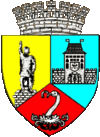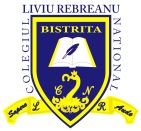Content
General Info
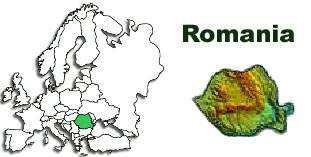 Country: Romania
Country: Romania
Capital city: Bucharest
Geographic position: in the south-east of Central Europe
Climate: temperate-continental, four seasons
Features: mountains, hills, plains, and delta
Population: 21,680,976 (March 2003, source: National Statistics Institute)
Ethnic structure: Romanians - 89.5%; Hungarians (including Szecklers)- 6.5%; Roma - 2.5%; other ethnic groups -1.5%
Religious structure: Eastern Orthodox - 86.7%; Roman-Catholic-4.7%; Protestant - 3.2%; Greek-Catholic - 0.9%, Evangelical - 0.1%; Unitarian - 0.3%; other religions - 0.4% (preliminary data, March 2003 )
Form of government: republic, NATO member, EU member since 2007
National Symbols
The National Coat of Arms

Romania's coat-of-arms has as a central element the golden eagle with a cross. Traditionally, this eagle appears in the arms of the Arges county, the town of Pitesti and the town of Curtea de Arges. It stands for the "nest of the Basarabs," the nucleus around which Wallachia was organized, the province that determined the historical fate of the whole Romania. The eagle, being the symbol of Latinity and a heraldic bird of the first order, symbolizes courage, determination, the soaring toward great heights, power, grandeur. It is to be found also in Transylvania's coat of arms. The shield on which it is placed is azure, symbolizing the sky. The eagle holds in its talons the insignia of sovereignty: a sceptre and a saber, the latter reminding of Moldavia's ruler, Stephen the Great and Saint (1457-1504), also called "Christ's athlete" whereas the sceptre reminds of Michael the Brave (1593-1601), the first unifier of the Romanian Countries. On the bird's chest there is a quartered escutcheon with the symbols of the historical Romanian provinces (Wallachia, Moldavia, Transylvania, Banat and Crisana) as well as two dolphins reminding of the country's Black Sea Coast. In the first quarter there is again Wallachia's coat-of-arms on azure: an eagle or holding in its beak a golden Orthodox cross, accompanied by a golden sun on the right and a golden new moon on the left. In the second quarter there is Moldavia's traditional coat-of-arms, gules: an auroch head sable with a mullet or between its horns, a cinque-foil rose on the dexter and a waning crescent on the sinister, both argent. The third quarter features the traditional coat of arms of Banat and Oltenia, gules: over waves, a golden bridge with two arched openings (symbolizing Roman emperor Trajan's bridge over the Danube), wherefrom comes a golden lion holding a broadsword in its right forepaw. The fourth quarter shows the coat-of-arms of Transylvania with Maramures and Crisana: a shield parted by a narrow fesse, gules; in the chief, on azure, there is an eagle sable with golden beak coming out of the fesse, accompanied by a golden sun on the dexter and a crescent argent on the sinister; on the base, on or, there are seven crenellated towers, placed four and three. Also represented are the lands adjacent to the Black Sea, on azure: two dolphins affronté, head down.
The Flag of Romania
 The flag of Romania is a tricolor: red, yellow and blue. It has not undergone many or major changes in the course of history. Only the distribution of the colors (in point of proportion and position) changed to a certain extent, being made equal after the Revolution of 1848. The Romanian tricolor (the colors red, yellow and blue are to be found also in Romania"s coat of arms) resisted, as a symbol, even after the advent of communism in this country, when the entire heraldry of the USSR"s satellites was reduced to a caricature.
The flag of Romania is a tricolor: red, yellow and blue. It has not undergone many or major changes in the course of history. Only the distribution of the colors (in point of proportion and position) changed to a certain extent, being made equal after the Revolution of 1848. The Romanian tricolor (the colors red, yellow and blue are to be found also in Romania"s coat of arms) resisted, as a symbol, even after the advent of communism in this country, when the entire heraldry of the USSR"s satellites was reduced to a caricature.
The flag of Romania has the colors placed vertically as follows: blue (hoist), yellow (in the middle) and red (fly). The width of each color band is one-third of the length. The blue is cobalt, the yellow-chrome and the red-vermillion.
A brief history
Romania is a country in Southeastern Europe. Its neighboring countries are: Hungary and Serbia to the West, Ukraine and the Republic of Moldova to the Northeast, and Bulgaria to the South.
To the East, Romania has a stretch of sea coast along the Black Sea. The country is located roughly in the lower basin of the Danube with almost all of the Danube Delta being located within its territory.
Antiquity |
The Greek historian Herodotus was the one to record the earliest written evidence of people living in the territory of the present-day Romania in 513 BC. In one of his books, he describes a military confrontation between the tribal confederation of the Getae and the Persian Emperor Darius the Great during his campaign against the Scythians. The Getae or the Dacians were a branch of Thracians that inhabited Dacia (corresponding to modern Romania, Moldova and northern Bulgaria). The Dacian kingdom reached its maximum expansion during King Burebista, around 82 BC. Later, historical sources mention several confrontations between the Dacians and the Roman Empire , with the latter defeating the former under Emperor Trajan in two campaigns stretching from 101 AD to 106 AD. As a result, the core of Dacian kingdom was turned into the Roman province of Dacia. Because the province was rich in ores, and especially silver and gold, the Romans heavily colonized the province, but in the 3rd century AD, with the invasions of migratory populations such as the Goths, the Roman Empire was forced to pull out of Dacia in 270 AD.
|
Middle Ages |
Between the 3rd century AD and the 14th century AD, Dacia was in turn invaded by several nomadic peoples, among which the Huns, the Gepids, the Avars, the Bulgarians, the Pechenegs, and the Cumans. To defend themselves against such invasions, the Romanian principalities of Wallachia and Moldavia were founded around 1310 and 1352, in the Souhern and Eastern parts of today's Romania, respectively. Romanians lived in three distinct principalities: besides Wallachia and Moldavia , there was also Transylvania, in the Western part of today's Romania, which was a part of the Kingdom of Hungary between the 10th-16th centuries.
|
1600 |
During the reign of Michael the Brave (Mihai Viteazul), the three Romanian principalities were for the first time united under a single rule. The unification lasted for less than a year and due to difficult historical conditions, the three principalities were separated again.
|
1859 |
Moldavia and Wallachia were reunited as a result of elections held in the two principalities. Their inhabitants chose Alexandru Ioan Cuza as their common ruler. Bucharest , the capital of the former Wallachia, became the capital of Romania .
|
1878 |
In the Treaty of Berlin, Romania was recognized as an independent state by the Great Powers.
|
1918 |
At the end of the First World War, Romania achieved its greatest territorial extent, uniting all the historical Romanian territories (including Transylvania, Bessarabia and Bukovina ). Bessarabia and Northern Bukovina were again separated from Romania in 1940.
|
1947-1989 |
In 1947, Romania became a people's republic, under a Communist rule. Subsequently, it became a socialist republic during Nicolae Ceausescu's regime, which started in the late 1960's. The Communist regime was overthrown as a result of the Romanian revolution of December 1989.
|
Present-day Romania |
After the fall of the Communist regime, Romania adopted a new constitution and started intense economic and political reforms. Romania joined NATO on March 29, 2004, and is also a member of the Latin Union, of the Francophonie and of OSCE. On January 1, 2007, Romania joined the European Union. Moreover, Sibiu, a large city in Transylvania , was chosen as European Capital of Culture in 2007.
|
Natural Environment
Romania boasts great biodiversity and unspoiled ecosystems. The vast territories of the Danube Delta, the big number of large carnivores and the huge wooded expanses in the Carpathian Mountains are among the most significant and best known aspects of Romania's natural wealth. Natural and semi-natural ecosystems stand for about 47% of the country¡¯s area, 783 types of habitat having been identified and defined.

Wildlife diversity is attested to by existing populations of wolf, bear, chamois and lynx, considered among the rarest in Europe, and also by vast unspoiled forest and alpine habitats associated with the Carpathians mountain range. Approx. 5600 bears, accounting for 60% of the European brown bear population, approx. 3000 wolves or 40% of the European wolf population, and approx. 1500 lynxes (40%) could provide the basis for reintroducing these species in other zones of Europe.
In the territory of Romania 3700 plant species were identified, of which 23 have been declared nature monuments, 74 are extinct, 39 are endangered, 171 are vulnerable, and 1253 are rare.
There are 1,234,710 hectares of protected natural sites in Romania or about 5.18% of the country's total area.
The climate
The climate of Romania is temperate-continental, with Atlantic and Mediterranean influences in the Southwest and with excessive elements in the East and Northeast.
Climatic variations are caused by geographical elements, the position of the main mountain ranges, elevation, etc. The average annual temperature varies with latitude, standing at 8¢ªC (45F) in the North and 11¢ªC (52F) in the South, with 2.6¢ªC in the mountains and 11.7¢ªC in the plains. In winter the Scandinavian (Arctic) anticyclone frequently affects this country, and the climate borrows features specific of the sub-polar Scandinavian climate.
Romanian sites on UNESCO World Heritage List
Danube Delta
 The Last European Sanctuary: the Danube Delta
The Last European Sanctuary: the Danube Delta
The Danube Delta flows into the Black Sea and form the largest and best preserved of Europe's deltas. The continuous stretch of reed beds is also said to be the largest in the world. The reeds act as a filter, making the water pure and drinkable.
The houses and hedges in this village have always been built with reeds. The houses are well-ventilated and insulated. The oven here is made by mixing shredded reeds with clay. Over 320 species of birds can be found here. There are Spoonbills. The bird got its name from the shape of its beak. And there is the Glossy Ibis with its bronze-coloured feathers. Tanase Ceico is making his way deep into the Delta by boat. He’s an Environment officer. His job is to preserve the nature here.
Migrating birds have become one of the symbols of the Danube Delta.These are white pelicans. They return here every spring all the way from Africa. They fish for food in large groups. Once they find a school of fish underwater, they form a large circle … and enclose the fish. The circle then begins to shift near to the shore, pushing the fish into shallow waters. The large gullet under the beak captures the fish in one swoop, just like a fishing net.
The Danube Delta is one of the world’s most fascinating places - it’s a remarkable sanctuary.
Churches of Moldavia
 Church walls entirely covered with colourful fresco paintings - a feature unique to the region of Moldavia in Romania.
Church walls entirely covered with colourful fresco paintings - a feature unique to the region of Moldavia in Romania.
Moldavia has long been called "the land where God lives". Many of the churches have frescoes here; seven of them have been inscribed as World Heritage. The Principality of Moldavia fought against Ottoman invasion in the fifteenth century and a church was built with each victory. The outside walls of the churches and monasteries were covered with Bible story paintings, so that people who were illiterate could understand the Biblical message. These pictures were painted by local peasants. Jesus, held in the arms of Virgin Mary, wears traditional peasant clothing. And here he is holding a cobza, a musical instrument of the region. The holy atmosphere in Moldavia attracts nuns from all over the country to serve God. Labour and prayer, reminiscent of medieval times can still be found here.
This is the village of Voronet. They adopted the name from the monastery. Horse drawn carriages are still a main means of transportation. This is the Church of St. George in the Voronet monastery. People celebrate the spring festival of St. George, the village’s patron saint, with the Saints drawn on the wall looking on. One of the special characteristics of the Moldavian frescoes is the vivid blue colour known as "the Voronet blue".
450 years have passed since these murals were painted, however the walls still retain the vivid blue colour to this day. "The Last Judgement" is considered to be the best mural in Moldavia. This wall mural depicts Heaven and Hell. Sinners are thrown into Hellfire. The Saints are in Heaven. Pious and righteous Moldavian people are here held in the arms of the Saints. The fresco churches have always been the heart of village life.
Monastery of Horezu
 Founded in 1690 by Prince Constantine Brancovan, the monastery of Horezu, in Walachia, is a masterpiece of the 'Brancovan' style. It is known for its architectural purity and balance, the richness of its sculptural detail, the treatment of its religious compositions, its votive portraits and its painted decorative works. The school of mural and icon painting established at the monastery in the 18th century was famous throughout the Balkan region.
Founded in 1690 by Prince Constantine Brancovan, the monastery of Horezu, in Walachia, is a masterpiece of the 'Brancovan' style. It is known for its architectural purity and balance, the richness of its sculptural detail, the treatment of its religious compositions, its votive portraits and its painted decorative works. The school of mural and icon painting established at the monastery in the 18th century was famous throughout the Balkan region.
Villages with Fortified Churches in Transylvania
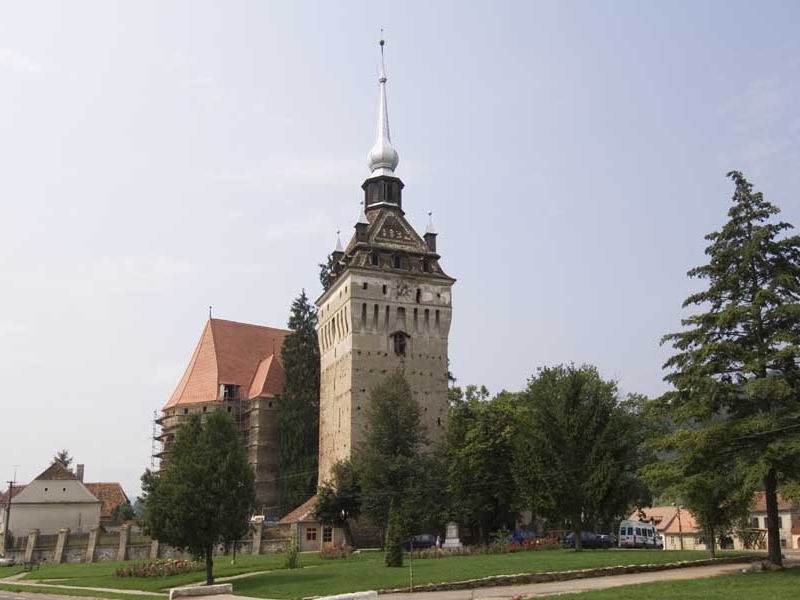 These Transylvanian villages with their fortified churches provide a vivid picture of the cultural landscape of southern Transylvania. The seven villages inscribed, founded by the Transylvanian Saxons, are characterized by a specific land-use system, settlement pattern and organization of the family farmstead that have been preserved since the late Middle Ages. They are dominated by their fortified churches, which illustrate building styles from the 13th to the 16th century.
These Transylvanian villages with their fortified churches provide a vivid picture of the cultural landscape of southern Transylvania. The seven villages inscribed, founded by the Transylvanian Saxons, are characterized by a specific land-use system, settlement pattern and organization of the family farmstead that have been preserved since the late Middle Ages. They are dominated by their fortified churches, which illustrate building styles from the 13th to the 16th century.
Dacian Fortresses of the Orastie Mountains
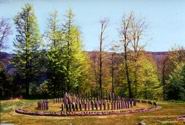 Built in the 1st centuries B.C. and A.D. under Dacian rule, these fortresses show an unusual fusion of military and religious architectural techniques and concepts from the classical world and the late European Iron Age. The six defensive works, the nucleus of the Dacian Kingdom, were conquered by the Romans at the beginning of the 2nd century A.D.; their extensive and well-preserved remains stand in spectacular natural surroundings and give a dramatic picture of a vigorous and innovative civilization.
Built in the 1st centuries B.C. and A.D. under Dacian rule, these fortresses show an unusual fusion of military and religious architectural techniques and concepts from the classical world and the late European Iron Age. The six defensive works, the nucleus of the Dacian Kingdom, were conquered by the Romans at the beginning of the 2nd century A.D.; their extensive and well-preserved remains stand in spectacular natural surroundings and give a dramatic picture of a vigorous and innovative civilization.
Historic Centre of Sighişoara
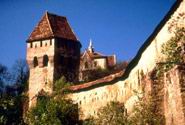 Founded by German craftsmen and merchants known as the Saxons of Transylvania, Sighişoara is a fine example of a small, fortified medieval town which played an important strategic and commercial role on the fringes of central Europe for several centuries.
Founded by German craftsmen and merchants known as the Saxons of Transylvania, Sighişoara is a fine example of a small, fortified medieval town which played an important strategic and commercial role on the fringes of central Europe for several centuries.
Wooden Churches of Maramureş
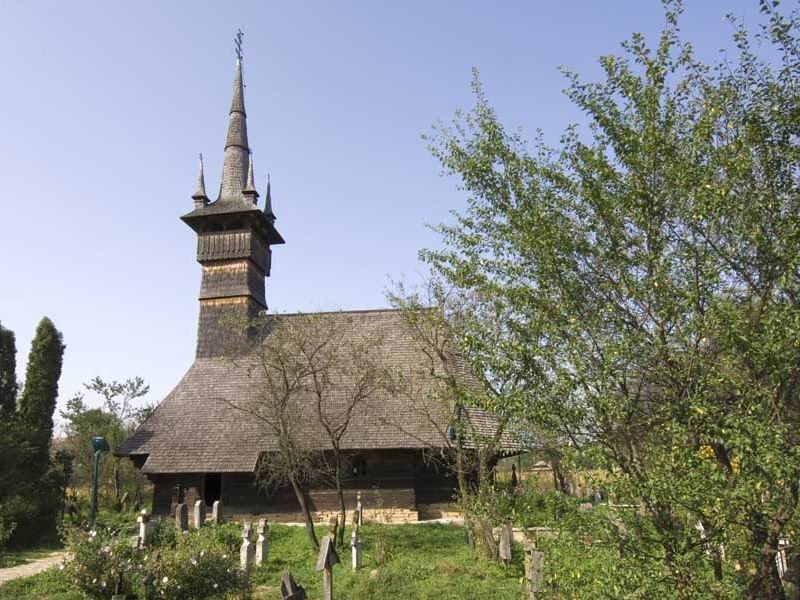 These eight churches are outstanding examples of a range of architectural solutions from different periods and areas. They show the variety of designs and craftsmanship adopted in these narrow, high, timber constructions with their characteristic tall, slim clock towers at the western end of the building, either single- or double-roofed and covered by shingles. As such, they are a particular vernacular expression of the cultural landscape of this mountainous area of northern Romania.
These eight churches are outstanding examples of a range of architectural solutions from different periods and areas. They show the variety of designs and craftsmanship adopted in these narrow, high, timber constructions with their characteristic tall, slim clock towers at the western end of the building, either single- or double-roofed and covered by shingles. As such, they are a particular vernacular expression of the cultural landscape of this mountainous area of northern Romania.

